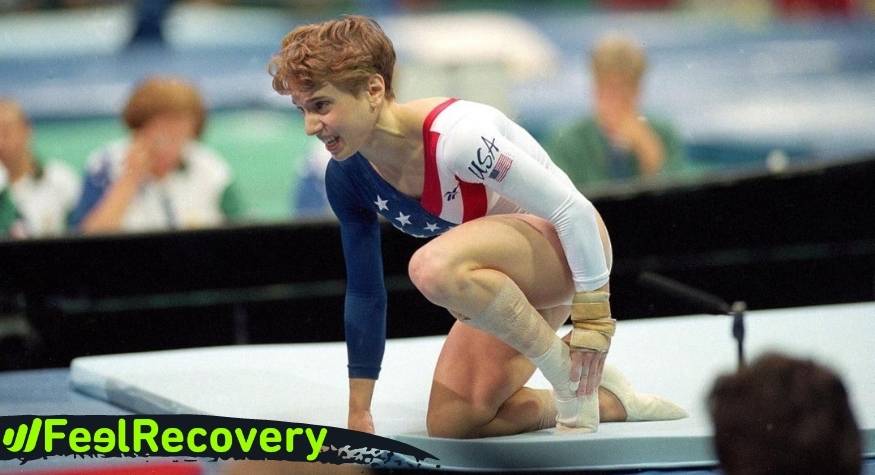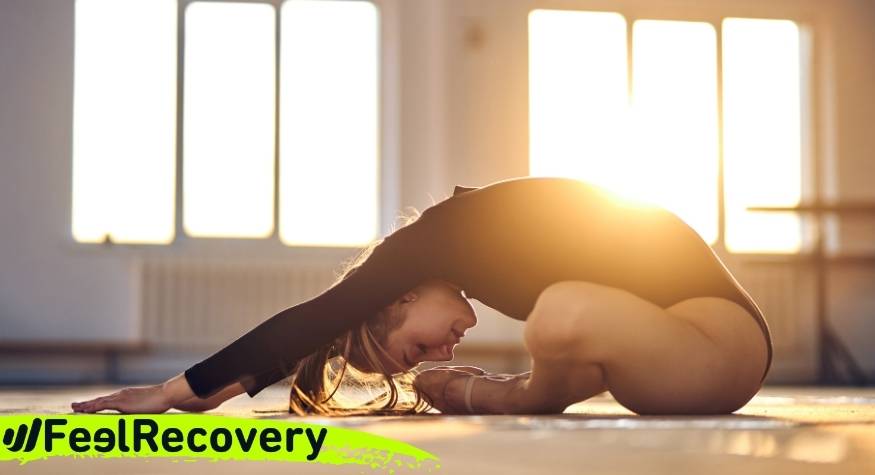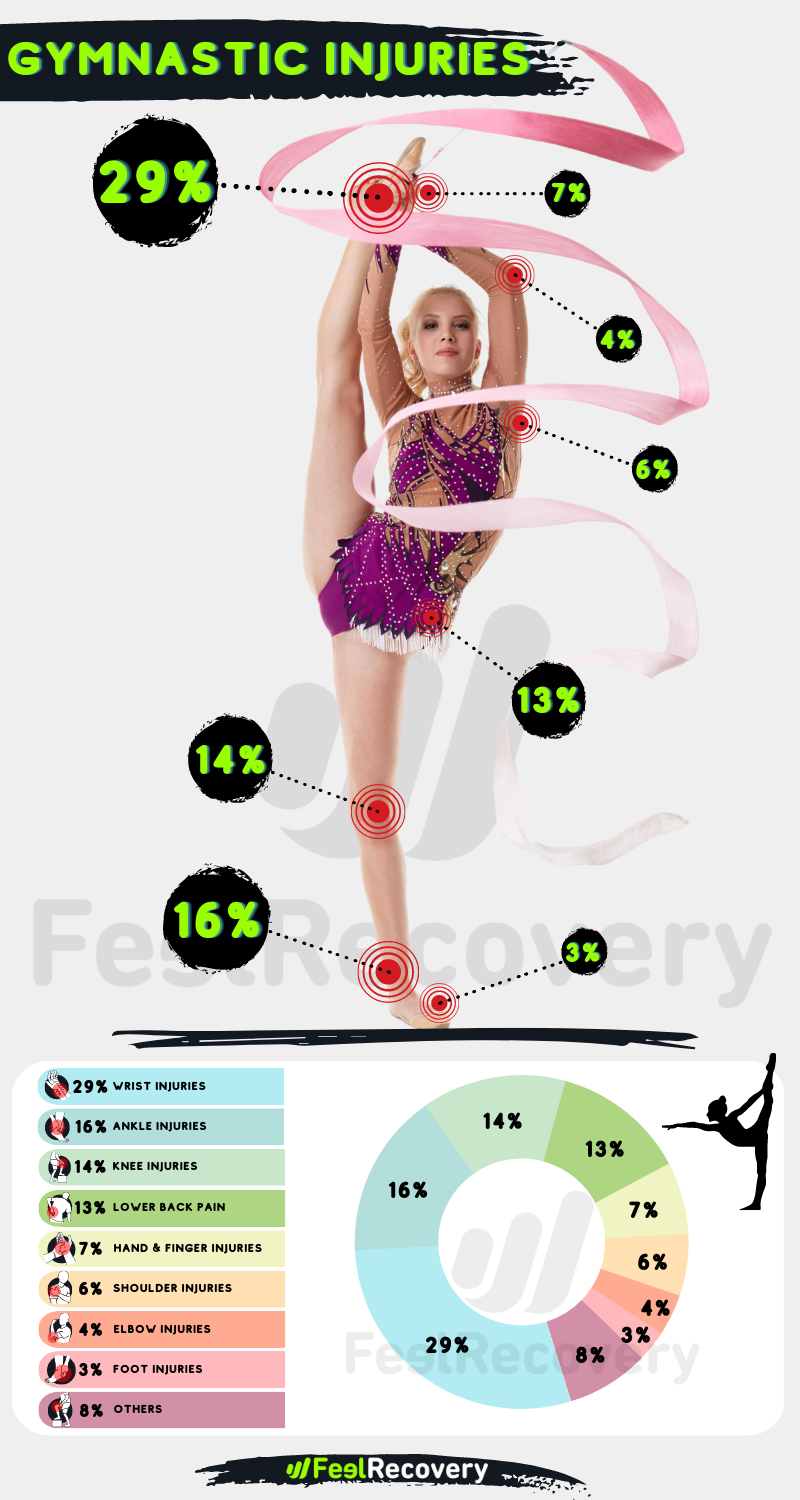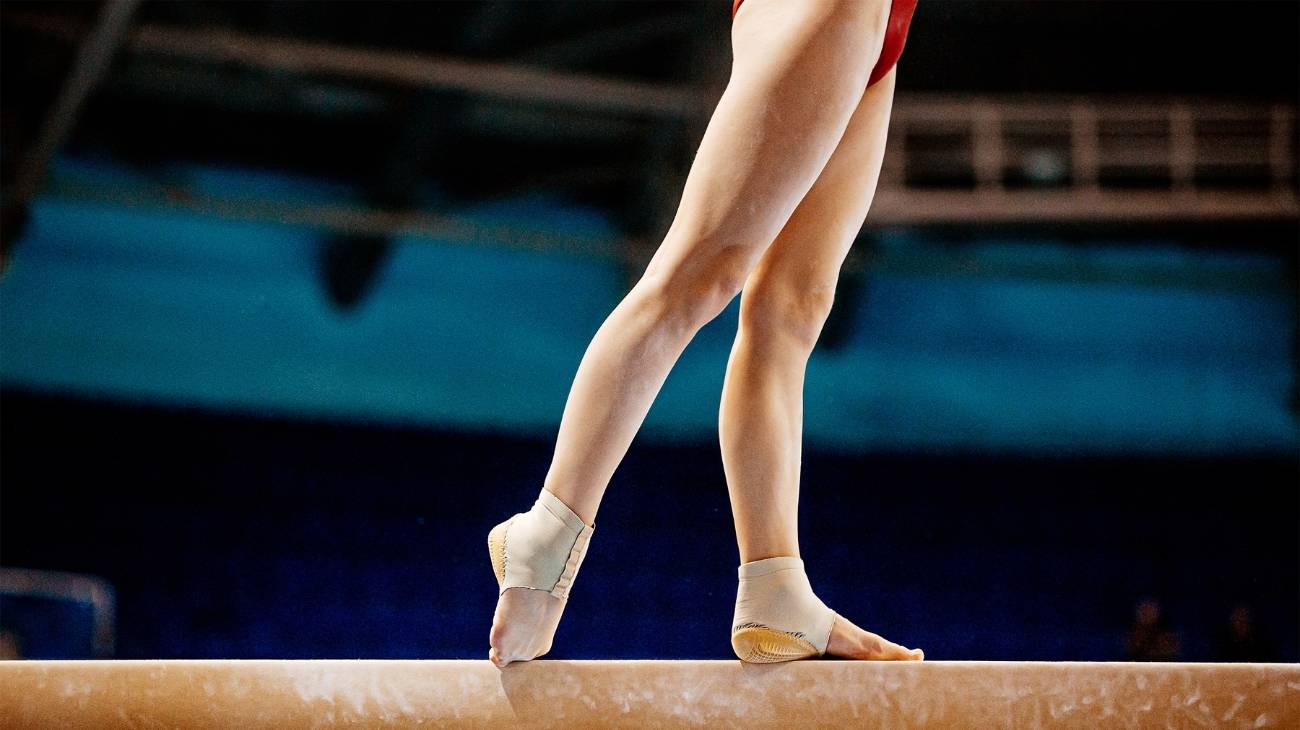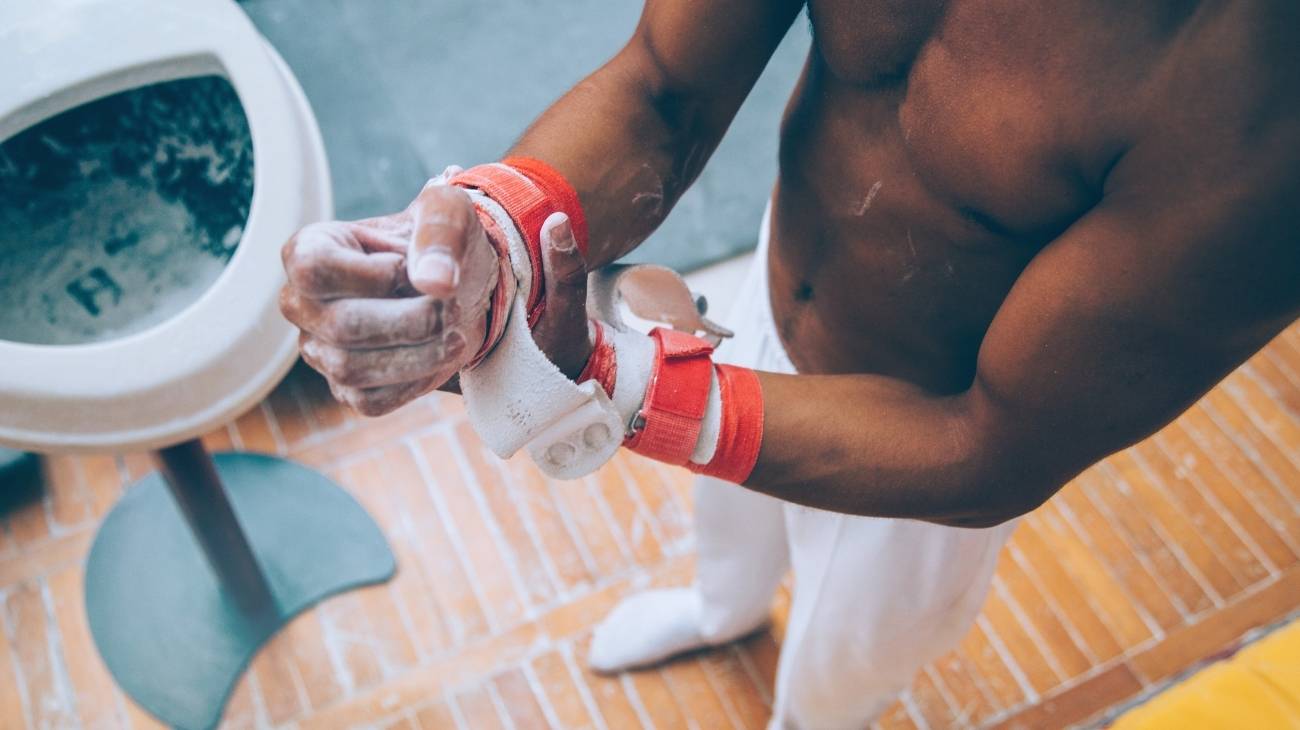Art, beauty and physical ability come together to dazzle with one of the most demanding and beautiful sports, where movements of extreme difficulty are shown, accompanied by music, and where choreographies of a high level are displayed, creating a unique spectacle called gymnastics.
For this, the athletes of this sport, resort to demanding training and as a consequence, are not exempt from suffering any injury, that is why we will discover what are the most common injuries when practicing gymnastics and how to prevent them
What are the most common types of sports gymnastics injuries?
Hands, feet, ankles, shoulders and legs can be injured when practising gymnastics.
We are going to mention the most common types of injuries in this discipline:
- SLAP: in the shoulder there is a ring of firm tissue that connects the shoulder to the arm, which provides stability and is called the Labrum. Injuries to this area of the shoulder, known as SLAP, can be torn during artistic gymnastics or overexposure of the joint. This injury is frequently seen in the use of the rings or any type of bars, since they demand more effort in the upper part of the shoulder.
- Elbow dislocation: The elbow joint is one of the most commonly injured areas in gymnastics, as it can be severely affected by pressure, poor positioning or falls. This type of injury occurs when the bone slips or slips out of the joint.
- Ankle sprains: these are very common in gymnastics as constant falls expose ankles to sprains that damage the ligaments that keep the joint stable, causing them to suffer partial or total tears that can heal in a few weeks with rest, or in the latter case, require surgery.
- Wrist sprains: the hands must be strong to avoid this injury, which is generated when the gymnast rests it on the floor to perform an acrobatic stunt and it loses stability and ends up making an unnatural movement that hurts one or more of the many ligaments and tendons that compose it.
- Cruciate ligament injury: many of the gymnastics modalities require perfectly coordinated falls after a few turns in the air, and many athletes injure the cruciate ligaments of the knee if they do not fall properly. The anterior cruciate ligament, which connects the femur to the tibia and stabilises the joint during the fall, is the one that suffers the most in these cases.
Best products for gymnastic injury recovery
Bestseller
-
2 Ankle Compression Sleeve (Black/Gray)
£17,50 -
2 Ankle Compression Sleeve (Green/Navy)
£17,50 -
2 Ankle Compression Sleeve (Pink/Bordeaux)
£17,50 -
2 Elbow Compression Sleeve (Black/Gray)
£17,50 -
2 Elbow Compression Sleeve (Green/Navy)
£17,50 -
2 Elbow Compression Sleeve (Pink/Bordeaux)
£17,50 -
2 Knee Compression Sleeve (Black/Gray)
£17,50 -
2 Knee Compression Sleeve (Green/Navy)
£17,50 -
2 Knee Compression Sleeve (Pink/Bordeaux)
£17,50 -
2 Thigh Compression Sleeve (Black/Gray)
£17,50 -
2 Thigh Compression Sleeve (Green/Navy)
£17,50 -
2 Thigh Compression Sleeve (Pink/Bordeaux)
£17,50 -
Acupressure Mat and Pillow (Black/Gray)
£44,95 -
Acupressure Mat and Pillow (Green/Navy)
£44,95 -
Acupressure Mat and Pillow (Pink/Bordeaux)
£44,95 -
Acupressure Pillow (Black/Gray)
£21,52 -
Acupressure Pillow (Green/Navy)
£21,52 -
Acupressure Pillow (Pink/Bordeaux)
£21,52 -
Foot Massage Roller for Plantar Fasciitis (Black)
£17,50 -
Foot Massage Roller for Plantar Fasciitis (Green)
£17,50 -
Foot Massage Roller for Plantar Fasciitis (Pink)
£17,50 -
High Density Foam Roller for Muscle (Black/Gray)
£24,95 -
High Density Foam Roller for Muscle (Green/Navy)
£24,95 -
High Density Foam Roller for Muscle (Pink/Bordeaux)
£24,95 -
Ice Massage Roller Ball (Black)
£34,95 -
Ice Massage Roller Ball (Green)
£34,95 -
Ice Massage Roller Ball (Pink)
£34,95 -
Microwave Wheat Bag for Neck & Shoulder Pain Relief (Hearts)
£21,50 -
Microwave Wheat Bag for Neck & Shoulder Pain Relief (Oxford)
£21,50 -
Microwave Wheat Bag for Neck & Shoulder Pain Relief (Sport)
£21,50 -
Microwave Wheat Bag for Neck Pain Relief (Hearts)
£17,50 -
Microwave Wheat Bag for Neck Pain Relief (Oxford)
£17,50 -
Microwave Wheat Bag for Neck Pain Relief (Sport)
£17,50 -
Microwaveable Wheat Bag for Pain Relief (Hearts)
£17,50 -
Microwaveable Wheat Bag for Pain Relief (Oxford)
£17,50 -
Microwaveable Wheat Bag for Pain Relief (Sport)
£17,50 -
Pack 2 in 1: Foam Roller High + Soft Density (Black/Gray)
£24,95 -
Pack 2 in 1: Foam Roller High + Soft Density (Green/Navy)
£24,95 -
Pack 2 in 1: Foam Roller High + Soft Density (Pink/Bordeaux)
£24,95 -
Soft Density Foam Roller for Recovery (Black)
£24,95 -
Soft Density Foam Roller for Recovery (Green)
£24,95 -
Soft Density Foam Roller for Recovery (Pink)
£24,95 -
Trigger Point Massage Stick (Black)
£12,95 -
Trigger Point Massage Stick (Green)
£12,95 -
Trigger Point Massage Stick (Pink)
£12,95
List of injury prevention methods in rhythmic or sport gymnastics
After suffering an injury, it can take a considerable time to return to any sport or gymnastics. This is because the training required to regain fitness, even to an excellent level, takes several months. It is therefore best to prevent many of these injuries by taking appropriate measures.
Here are the most important ones:
Warming up properly
It is easier to suffer an injury when our body is not prepared for action, which is why most muscle injuries occur due to a lack of warm-up.
One of the most important warm-ups for gymnasts is to stretch all the arm muscles; shoulder, biceps, triceps, deltoids and trapezius, as these muscles are going to receive a high load at the time of a performance and must be prepared correctly.
In the lower limbs, you must stretch especially the hip area, the fascia lata, and very specifically the musculature of the toes and ankle which are the peroneus anterior muscle, tibialis anterior, extensors of the toes and other important muscles. In this way they will all be prepared for the activity and will be less prone to sprains and other types of injuries.
Finish your workouts with a cool down
For a good recovery after a gymnastics workout, it is essential to have a cool-down period. This consists of lowering the intensity, since when practising this sport our body is in a constant activity and the dry stop of this can bring physical consequences, such as muscle discomfort, spasms, dizziness, muscle tension and possible injuries.
It is therefore important after each section of training to lower our heart rate, perform breathing exercises or passive stretching, both legs, arms and back slowly, in order to reduce the tension generated. The return to calm after a session is important for a better recovery.
Good nutrition and hydration
The food we eat has a big impact on our athletic performance as gymnasts, and to prevent injuries it is necessary for our muscles, bones and joints to be healthy and this can only be achieved by providing them with the nutrients and vitamins they need.
This can be achieved by eating a good balanced diet of fats, proteins and carbohydrates, by eating good quality fruit and dairy products, nuts, all types of vegetables and wholegrain carbohydrates. However, the best way to ensure that we are getting the best nutrition is to visit a nutritionist specialised in sports nutrition so that they can provide us with a personalised diet plan in accordance with our daily requirements.
As for hydration, you should drink water during each training session, not wait until you feel thirsty, as this is the first symptom of dehydration. The ideal is to drink small sips every 20-25 minutes during breaks.
Improve your fitness
Our body should be the centre of attention not only in rhythmic gymnastics, but also in a healthy lifestyle in order to stay in shape and prevent multiple injuries.
Healthy lifestyle habits such as sleeping well, taking time to exercise, taking care of our body position and gradually increasing our physical activity will help us a lot. It is always advisable to have an external exercise programme that will provide us with the necessary aerobic and anaerobic endurance.
If you practise gymnastics in a club, the trainer or physical trainer will be in charge of providing you with the most suitable workouts for your level and sporting discipline. You should always progress little by little so that your physical capacities become accustomed to the new acrobatics and increasingly demanding exercises.
Sports massage
This is an excellent way to prepare your body for physical activity or to relax your muscles afterwards. Physiotherapists can apply different types of massage in order to release tension in the muscles and joints.
Sports massage techniques vary from kneading and percussions to assisted joint massage, all with the intention of stimulating the release of endorphins from the body that promote muscle recovery after an intense gym training session.
Use of heat and cold therapies
Cold is widely used to reduce inflammation in any affected area, being ice packs the ones we can mostly apply if we start to feel any pain in our body, relaxing the muscle and improving its plasticity, this technique should be used around 5 to 10 minutes.
The use of heat before entering our practice session, will produce a relaxing effect, thanks to the vasodilation that will occur throughout our muscle tissue, where the muscles will be much more flexible and adaptable to the sport.
Use of compression garments
Using the right equipment will prevent multiple injuries, nowadays the use of compression garments is very common not only to maintain body heat, but also because it improves blood circulation, reduces discomfort from vibrations when falling, improves recovery after physical activity, and reduces the possibility of suffering an injury.
The most popular use among gymnastics athletes is compression stockings that provide extra support to the lower body, although leotards worn during competition can also be considered compression garments.
Use of acupressure therapies
Applying pressure to specific points on the body with the thumb or palms of the hands for a moderate amount of time is called acupressure, and is an extremely useful practice for getting the body to release accumulated tension in specific muscle areas and joints, greatly reducing the chance of stress injuries.
However, this is not a practice that can be applied by just anyone, but by a trained professional, as failure to stimulate the pressure points properly can lead to pain and other counterproductive effects.
Use of thermotherapy and cryotherapy
The use of heat on the body is known as thermotherapy, and causes a vasodilation effect. It is normally used to prepare the muscle for physical activity, which is why it is very effective in preventing injuries, as well as improving muscle extensibility.
As for the use of cryotherapy, either by a solid or liquid medium, it will produce a vasoconstriction effect generating benefits such as the reduction of inflammation, as well as providing effective pain relief for muscle spasms or sprains. It is usually used after a gymnastics workout.
Use of good equipment
The facilities where gymnastics is practised or trained must have the necessary equipment and be in optimal condition. In order to be able to develop a good training in all modalities, there must be a space that has the Potro, balance bars, fixed and parallel bars, and the rings or rings. The ribbon, rope, ball and clubs are also essential for women's rhythmic gymnastics.
Also important is the clothing, which must be close-fitting and sufficiently elastic for the gymnast to perform his acrobatics, with leotards being the most commonly used for both men and women.
References
- Meeusen, R., & Borms, J. (1992). Gymnastic injuries. Sports Medicine, 13, 337-356. https://link.springer.com/article/10.2165/00007256-199213050-00004
- Caine, D. J., & Nassar, L. (2005). Gymnastics injuries. Epidemiology of pediatric sports injuries: individual sports, 48, 18-58. https://www.karger.com/Article/Abstract/84282
- Garrick, J. G., & Requa, R. K. (1980). Epidemiology of women's gymnastics injuries. The American journal of sports medicine, 8(4), 261-264. https://journals.sagepub.com/doi/abs/10.1177/036354658000800409
- Sands, W. A., Shultz, B. B., & Newman, A. P. (1993). Women's gymnastics injuries: a 5-year study. The American journal of sports medicine, 21(2), 271-276. https://journals.sagepub.com/doi/abs/10.1177/036354659302100218
- Caine, D., Cochrane, B., Caine, C., & Zemper, E. (1989). An epidemiologic investigation of injuries affecting young competitive female gymnasts. The American journal of sports medicine, 17(6), 811-820. https://journals.sagepub.com/doi/abs/10.1177/036354658901700616
- Cavallerio, F., Wadey, R., & Wagstaff, C. R. (2016). Understanding overuse injuries in rhythmic gymnastics: A 12-month ethnographic study. Psychology of sport and exercise, 25, 100-109. https://www.sciencedirect.com/science/article/abs/pii/S1469029216300516
- Zetaruk, M. N., Fors, M. V., Zurakowski, D., Mitchell Jr, W. A., & Micheli, L. J. (2006). Injuries and training recommendations in elite rhythmic gymnastics. Apunts: Medicina de l'esport, 100-106. https://www.raco.cat/index.php/Apunts/article/view/164833
- Daly, R. M., Bass, S. L., & Finch, C. F. (2001). Balancing the risk of injury to gymnasts: how effective are the counter measures?. British Journal of Sports Medicine, 35(1), 8-19. https://bjsm.bmj.com/content/35/1/8.short
- Sands, W. A. (2000). Injury prevention in women’s gymnastics. Sports medicine, 30, 359-373. https://link.springer.com/article/10.2165/00007256-200030050-00004
- Bradshaw, E. J., & Hume, P. A. (2012). Biomechanical approaches to identify and quantify injury mechanisms and risk factors in women's artistic gymnastics. Sports Biomechanics, 11(3), 324-341. https://www.tandfonline.com/doi/abs/10.1080/14763141.2011.650186

